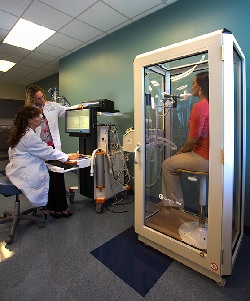
Career Opportunities and Trends for Respiratory Therapists
By Debra Wood, RN, contributor
 Valued members of the healthcare team, respiratory therapists (RTs) assist in the diagnosis and treatment of patients with cardiorespiratory conditions. The field is continually evolving, due to changes in chronic disease management, technology, and healthcare delivery. Today, the field offers career opportunities ranging from permanent positions in acute care and outpatient settings to a variety of job possibilities for travel respiratory therapists.
Valued members of the healthcare team, respiratory therapists (RTs) assist in the diagnosis and treatment of patients with cardiorespiratory conditions. The field is continually evolving, due to changes in chronic disease management, technology, and healthcare delivery. Today, the field offers career opportunities ranging from permanent positions in acute care and outpatient settings to a variety of job possibilities for travel respiratory therapists.
ASK the experts at Med Travelers about careers in travel respiratory therapy.
Expanding roles for today’s RTs
“Respiratory therapists have an expanding role,” said Paul J. Scalise, MD, FCCP, executive vice president, and chief medical officer for the Hospital for Special Care in New Britain, Conn., which employs about 100 respiratory therapists. “I see it with disease management programs, where they are the point person for patients.”
RTs provide education, navigation, and disease management for chronic obstructive pulmonary disease (COPD) and other outpatient respiratory patients at the Hospital for Special Care.
“The scope of practice is growing, and we are doing more,” said Lisa Farach, MS, RRT, RN, department chair, cardiopulmonary sciences at Nova Southeastern University in Palm Beach, Fla. “We are using technology and evidence-based practice and taking on more duties at the bedside.”
Throughout healthcare, more services are moving into the community, with an emphasis on prevention and preventing readmissions. While not directly reimbursed for delivering care in the home, respiratory therapists may play a bigger role in the future keeping patients healthier at home and prevent COPD readmissions, for which hospitals will not be reimbursed.
Respiratory therapist jobs and pay
Experts anticipate the need for more <respiratory therapist jobs> in the years ahead. Approximately 120,700 RTs practice in the United States, according to the Bureau of Labor Statistics, and they report an average respiratory therapist salary of nearly $58,000 annually. RTs must be certified, as CRTs, and later can become registered, as RRTs. The pay for <travel respiratory therapists> is very competitive and will vary based on location, employer, and the therapist’s experience and qualifications.
“The salary is good for the level of education you need,” Farach said. RTs can enter the profession with an associate’s degree. However, she added that many hospitals are wanting RTs with a bachelor’s degree for COPD education positions, where therapists follow up with patients to make sure they take their medications and keep appointments with the physician.
The government expects the number of RTs to increase 12 percent by 2024, faster than the average for all occupations.
“This is the result of aging baby boomers, with approximately 10,000 people turning 65 every day in the United States,” said Robert L. Joyner Jr., Ph.D., RRT, RRT-ACCS, FAARC, associate dean of the Richard A. Henson School of Science & Technology at Salisbury University in Maryland.
Older adults suffer more than younger people with COPD, heart disease, sepsis, and pneumonia, for instance. Farach also reported many RTs are reaching retirement age, which is creating demand for new therapists to enter the field.
Long-term and intensive care
While not entirely new, long-term acute care hospitals (LTACs) have increased the need for respiratory therapists to assist with mechanical ventilator care, secretion clearance devices, and other intensive care. A 2014 study by the American Association for Respiratory Care found an increase in employment at LTACs, from 4.4 percent in 2009 to 7.6 percent in 2014.
“With the number of respiratory patients we have, respiratory therapists have a prominent role here,” Scalise said.
RTs play a critical role in helping ambulate vented patients. An RT may need to use an Ambu bag to deliver oxygen as the patient walks.
“In the last few years, we have seen more attention to mobility in the ICU,” Scalise said. “We’ve always known it was important.”
Changes in technology
As with other facets of healthcare, changing technology affects the field of respiratory therapy.
“Respiratory care is a field filled with technology,” Joyner said.
Equipment is bound to become easier to use, with fewer opportunities for error, while at the same time becoming more complex, according to an article by futurist Joe Flower in RT: For Decision Makers in Respiratory Care, who predicts networked automation will allow blood oxygenation monitors to change settings on respiratory devices, without the assistance of an RT. Scalise mentioned newer and easier-to-wear CPAP and Bi-PAP masks are helping patients with adherence to the plan of care. Farach reported that ventilators are becoming more complex.
In order to provide the best care and help patients of all ages breathe better, staff and travel respiratory therapists alike must stay abreast of the latest equipment and research, and adjust their practices accordingly.
“[Respiratory therapy] is an excellent opportunity for people who want to get into healthcare but do not want to be a doctor or a nurse,” Farach said.
<APPLY NOW> for travel jobs in respiratory therapy and other <allied health disciplines>.
© 2016. AMN Healthcare, Inc. All Rights Reserved.


